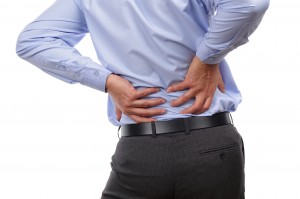
More evidence that low-calorie sweeteners are bad for your health
Studies show that artificial sweeteners can raise the risk of hypertension, metabolic syndrome, type 2 diabetes and heart disease, including stroke.

Back pain is an increasingly common problem for many of us.
Around 8 out of 10 of adults will experience significant low back pain sometime during their life and it is most common among adults aged between 35 and 55 years. When it strikes it can be very debilitating and and keep you from fully participating in everyday activities and even prevent you from working.
The most common reason for back pain, say experts, is work-related back injuries, but activities at home and at play can also result in back pain.
The human back is composed of a complex structure of muscles, ligaments, tendons, disks and bones – the segments of our spine are cushioned with cartilage-like pads. Problems with any of these components can lead to back pain. In some cases of back pain, its cause is never found. Although doctors mostly understand the mechanics of back pain their attempts to treat it are often ineffective over the long run. Pain relievers can temporarily block the sensation of pain but do little to keep the pain from coming back or to get to the root cause of the pain.
Here are some simple, effective ways to keep the strains of everyday life from turning into intractable pain.
Good posture. It can take years (or even decades) for pain, stiffness and other symptoms to develop in response to poor posture. Don’t wait for the pain to start. When standing keep a neutral pelvic position. Try alternating placing your feet on a low footstool to take some of the load off. When sitting keep your knees and hips level and choose a chair with good lower back support or place a pillow or rolled towel in the small of your back to maintain its normal curve. When driving make sure that your lower back is properly supported. Correctly positioning your seat and side mirrors will prevent you from having to twist around. Your foot controls should be squarely in front of your feet.
Stay active. A sedentary lifestyle raises you risk of low back pain. If your job involves a lot of sitting, make sure you balance that out with exercises and activities that keep you moving.
Focus on flexibility… Exercises like yoga are particularly good for keeping the spine flexible and less prone to injury.
…then work on strength. Back pain sufferers often have weak, poorly functioning back muscles. Regular aerobic activities that don’t strain or jolt can increase strength and endurance in your lower back, allowing your muscles to work better. Good choices include walking, swimming and biking.
Acupuncture has a good track record for relieving pain of all kinds. It has been shown to relieve chronic low back pain more effectively and for longer than conventional orthopaedic treatments. Regular treatments may prevent relapses of back problems.
Visit a chiropractor or osteopath. Back pain can sometimes be caused by simple structural problems and recent evidence suggests that osteopathy is more effective at relieving pain than ultrasound.
Lift carefully. Push rather than pull when you must move heavy objects. If you have to lift, let your legs do the work. Hold the load close to your body and keep your back straight and bend only at the knees. Avoid lifting and twisting simultaneously.
Sleep smart. Old saggy mattresses can make pain worse – so can over firm ones. Evidence suggests that sleeping on a medium-firm mattress can improve low back pain and result in less daytime pain and disability and lower use of pain-killing drugs. Use pillows for support, but don’t use a pillow that forces your neck up at a severe angle.
Wear flat shoes or shoes with low heels (1 inch or lower).
Destress Yes, stress can even raise your risk of back pain due to stress-related muscle tightness. Make sure you take time out, and engage in hobbies that allow you to relax completely. Making time for a regular massage may also help
Quit smoking. It is associated with more low back pain and evidence shows that nicotine increases pain and those who do quit experience less back pain than those who continue to smoke.
Consider losing weight. If you are overweight, may experience sciatica and low back pain from a herniated disc or a pinched nerve caused by compensating for the weight. If you are carrying extra weight around the mid-section, it can pull the pelvis forward, creating stress on the lower back.
Supplement. A combination of vitamins B1, B6 and B12 has proved useful for preventing a relapse of back pain linked to vertebral problems as well as reducing the amount of anti-inflammatory medications needed to control pain. Around 50-100 mg each of vitamins B1 and B6, and 250-500 mcg of vitamin B12, three times daily, is considered therapeutic.
Proteolytic enzymes, including bromelain, papain, trypsin and chymotrypsin, may help heal minor injuries because they are anti-inflammatory and capable of being absorbed from the gastrointestinal tract. Several small trials show that bromelain and papain can help reduce pain and swelling and promote faster healing in people with a variety of conditions including back strain.

Please subscribe me to your newsletter mailing list. I have read the
privacy statement